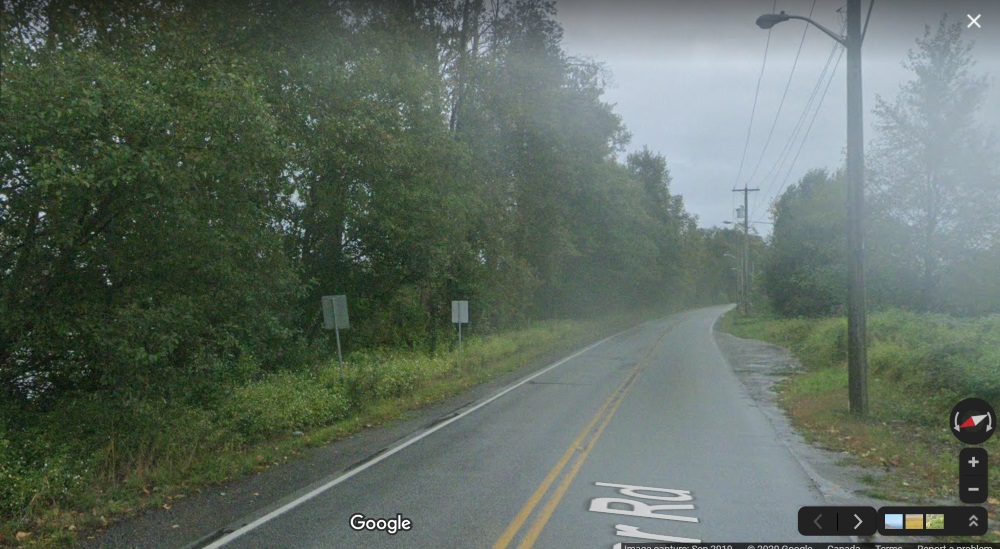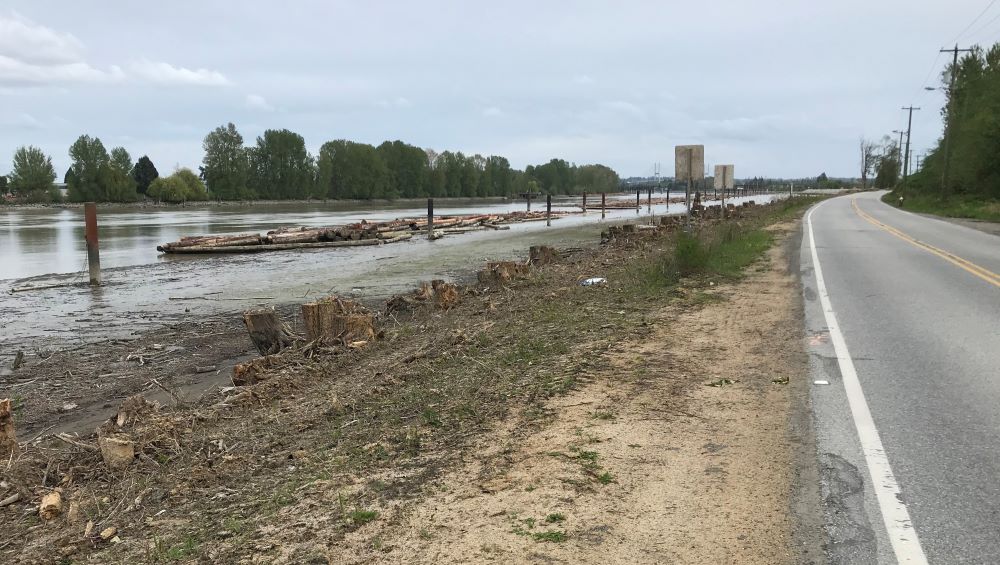Denis asks—
Hi Pat, I was cycling along River Road in Richmond for the first time in quite some time this morning and noticed that the trees between the road and the Fraser had been cut along a ~0.5-1 km stretch, perhaps (my memory is fallible!) just to the east of the CNR bridge? I was sad to see that this had been done when I can’t think of any real need — any idea why this was done and whose approvals were necessary? I’m thinking this stretch is actually in Richmond rather than New West, but I figured if anyone would know or could find out about this it would be you!
Hey Denis! Long time no see, hope you and yours are well! This is a little outside of New West, but quite a few of my cycling friends have asked this question, so I’ll take a stab at answering. Besides, I probably owe you a noteworthy number of favours.
Indeed there is a ~1 km-long stretch of River Road in east Richmond just west of the rail bridge where a significant number of trees and pretty healthy looking habitat was recently clear cut. Where this used to be the view riding along there:
It now looks like this:
There is a pretty simple reason for why it was done. The City of Richmond has an ongoing program to improve and solidify the dike system that keeps Richmond (and Queensborough!) livable and farmable, and this is part of that program. With funding support from the Provincial and Federal Governments, the entire dike-and-drain system for Lulu Island is being upgraded. This means raising some areas of dike to meet new 100-year projections for sea level rise and seismically upgrading parts of the dike where sloughing or liquefaction is likely during a significant earthquake. It also means upgrading the internal canal/ditch/watercourse network and pumping infrastructure that not only keeps the rainwater from flooding within the dike, but serves as an important emergency reservoir and drainage system to reduce damage in the unlikely event of a breach of the dike.
I am not an engineer, but my understanding is that there is some stability and lift work being done on this stretch of dike, and the (primarily) cottonwoods were determined to be both a threat to the soil density and in the way of the soil improvement work that needs to occur, so they needed to go. There is more info here at the City of Richmond website.
Your second question is a bit harder to answer, and I can only really answer in generalities, because I was not involved in this specific project, and I’m not a Professional Biologist. So take everything below as referring to “a typical project like this” and not referring to this specific project, because it is complicated and I don’t want to second guess actual professional people who might have been involved in this project. Geologists talking Biology always get something wrong, but I have spent some of my career peripheral to this type of ecology work, so here is my understanding.
The City has rules about cutting trees and protecting habitat. If you wanted to do this type of clear-cut to build a house or a warehouse or a dock, you might run into that. But a City-run project regulated by a provincial diking authority for life safety reasons would likely be exempt from those types of Bylaws.
Provincially, there is a law called the Riparian Areas Regulation that requires municipalities to regulate the protection of “riparian areas”, which are the lands adjacent to a fish-bearing or fish-supporting stream and provide shade, habitat, nutrients, etc. to the critters that live in and near the stream. In general, RAR does not apply in tidal waters, and the Fraser River here is tidal. So that leaves the Feds, and the biggest, baddest, environmental hammer in Canada: the federal Fisheries Act.
This used to be simple. Back in, say, 2011, work like this would constitute a HADD – “Harmful Alteration, Disruption or Destruction of fish habitat”. Section 35 of the Fisheries Act said you couldn’t do that without specific authorization. That authorization was hard to come by, but if the work was important like upgrading dikes, expanding the Port, or building an oil pipeline, you could get approval that would come along with a bunch of restoration work. If you were working in tidal waters or in the riparian areas near tidal waters, the onus was on you to prove to well-trained and independent scientists at the Department of Fisheries and Oceans (DFO) that your work did not constitute a HADD, and if it did, they were going to make you fix what you broke.
Naturally, that was a bummer to some people who liked to build things in and near fish habitat, like oil refineries and pipelines, or if you wanted to hold a good ol’ Country Hoe-Down in a sensitive habitat. So the Harper Conservatives ripped HADD out of the Fisheries Act. Instead of protecting habitat, your only responsibility is to not cause “serious harm” to a fish. They also canned a great many of those well-trained DFO scientists who would actually be the ones able to determine if there was harm. So for several years, reviewing a project like cutting down all the trees on a 1km-long stretch of Fraser River foreshore was left to an on-line triage system run out of Regina, and evidence to support that review could be provided by pretty much anyone – no requirement for a Professional Biologist to provide assessment to determine if this was a bad thing for fish, or any other part of the ecosystem. Some environmentalists complained at the time.
Now, the Liberal government put the HADD back into the Fisheries Act late last year, and with it there was a return of authorizations under Section 35. There is still an issue with limited resources in the DFO to provide those authorizations, and I honestly have no idea what the triggering mechanism is compared to how it was pre-2012, or whether a project like this would trigger it. It may have received review through the old triage system prior to the changes in the Act, it may have had full DFO Section 35 review.
Anyway, it looks bad now, and to my untrained and non-biologist eye like a HADD, but this is important dike work making Lulu Island safer from flood and earthquake, so it would very likely have received a DFO authorization, and a compensation plan to improve the habitat value of the river would be required. The City of Richmond mentioned a plan to plant more than twice as many trees as were removed, so there will be a habitat win here eventually. Hopefully, they are also looking at improvements to River Road along with the Dike improvements, to make it a safe place to ride bicycles. But that’s a whole different rant.